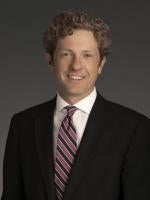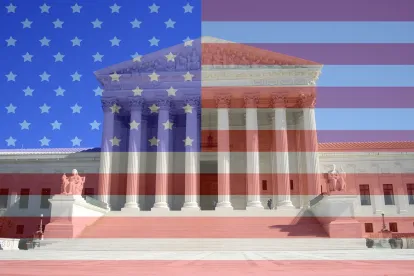Greetings, Court Fans!
As we promised last week, we're back with the final bit of mop-up from the exciting end of the 2017–18 term. And we've saved some of the best (or maybe the worst) for last with three significant, much-awaited 5-4 decisions.
First up, in Janus v. American Federation of State, County & Municipal Employees (16-1466), the Court (finally) overruled Abood v. Detroit Board of Ed. (1977), holding that requiring public-sector employees who are not union members to pay "agency fees" to a union violates the First Amendment. Although the case arose in Illinois, it's all but certain to have widespread impact across the country, as more than twenty states have laws similar to those at issue in the case.
Illinois law permits public-sector employees to unionize. If a majority of employees in a bargaining unit vote to be represented by a union, that union serves as the exclusive bargaining agent for all employees, including those that do not join the union and who may actively oppose the union's views. Union members are charged dues that cover both expenses related to collective bargaining (referred to as "chargeable" expenses) as well as expenses for the union's political and ideological activities (referred to as "nonchargeable" expenses). Those employees who choose not to join the union are charged an agency fee, which is supposed to include only chargeable, collective bargaining-related expenses. This approach was approved by the Court in Abood, which held that nonunion members could be required to share in the cost of collective bargaining-related expenses (for which they would receive the benefits) but not for the union's political activities.
Facing a fiscal crisis made more challenging by the Illinois public-employee union's bargaining positions, Illinois's Governor brought a lawsuit challenging the constitutionality of the state law authorizing agency fees. Although his suit was later dismissed for lack of standing, Mark Janus, a state employee who opposed the union that represented his bargaining unit was allowed to intervene and then to file his own complaint to continue the suit. But the district court dismissed his claim too, concluding that it was bound to uphold Illinois's law under Abood. The Seventh Circuit affirmed, squarely teeing up the continued validity of Abood for the Court.
If you're getting a sense of déjà vu, it's with good reason. Avid readers (and other Court followers) may recall that the Court has come close to overruling Abood twice in the last few terms. In the first of these, Harris v. Quinn (2013), the Court's more conservative justices blinked, holding that the employees at issue in that suit were not public employees at all. The Court next faced the issue in Friedrichs v. California Teachers Association (2016), where it looked set to overrule Abood until Justice Scalia unexpectedly died, leading to a summary 4-4 affirmance. Thus, with eight of the Justices having already offered their views about Abood just two years ago, the only vote up for grabs was that of Justice Gorsuch. It turned out to be just as much up for grabs as Court watchers expected (i.e., not much).
Justice Alito wrote for a five Justice majority, striking down Illinois's agency fee law. The Court first explained that forcing individual employees to support (i.e., fund) views with which they disagree raises serious First Amendment concerns "and, in most contexts, would be universally condemned." Coerced speech is always suspect under the First Amendment, because it forces individuals to betray their own convictions. And compelling a person to subsidize another private speaker's views raises similar concerns. Regardless of whether "strict scrutiny" or the somewhat lesser "exacting scrutiny" standard should be applied, the Court concluded that public-sector agency fees must fail, because even under less-demanding exacting scrutiny, a compelled subsidy can only be upheld if it serves a compelling state interest that cannot be achieved through means significantly less restrictive of associational freedoms.
Four decades earlier, Abood found this standard satisfied based on states' interests in maintaining labor peace. Abood believed that labor peace was dependent on having an exclusive bargaining representative (i.e., a single union to represent all employees) and that this could only be achieved by forcing all employees to support the costs of this union (i.e., avoiding free riders). But the Court concluded Abood's reasoning had not proven true over time, as many states and the federal government have laws permitting employees to unionize and requiring the union to represent all employees' interests (not just union members) without requiring non-participating employees to pay union dues. The Court found no evidence that labor unrest has resulted or that free riders have killed off unions, so, the Court reasoned, experience has shown that the interests identified by Abood are insufficient to support agency fees today.
The Court also quickly dispensed with the union's argument that the First Amendment was originally understood to provide no protection for public employee speech. While the First Amendment may permit a state employer to direct an employee's speech within the course of their employment, a historical review of the Court's decisions did not support the notion that the First Amendment did not apply generally to state employees. And bargaining speech by the union cannot reasonably be understood as speech being directed by an employer within the scope of employment—rather, it is often adverse to the employer.
Finally, the Court rejected the union's argument that a lesser standard of review (akin to rational basis review) should be applied because the union's activities only concern matters of private concern. In the public sector, the Court reasoned, decisions about employee pay and other conditions of work (such as whether teachers have tenure) have serious repercussions for the budget of the State and for all citizens, making them matters of public concern. Given these problems (as well as difficulties applying Abood, such as determining what costs were chargeable), the Court concluded that principles of stare decisis did not justify retaining it. The result: public-sector unions may no longer extract agency fees from nonunion members.
Justice Kagan, joined by Justices Ginsburg, Breyer, and Sotomayor, dissented. In their view, Abood's line permitting a government entity to require employees to pay a fair share of the union's collective bargaining expenses, but not its political expenses, "fit comfortably with this Court's general framework for evaluating claims that a condition of public employment violates the First Amendment." Historically, the Court has made clear that government entities had "substantial latitude" to regulate their employees' speech regarding the terms of employment. And Abood did just that while protecting employees from being compelled to support political speech with which they disagreed. The dissent worried that the decision would have far-reaching impact on public-employee unions in the more than twenty states with schemes similar to Illinois. Justice Sotomayor joined Justice Kagan's dissent in full, but wrote separately to note that while she had joined the Court's decision in Sorrell v. IMS Health Inc. (2011), she agreed with Justice Kagan that it had been wrongly interpreted, and had allowed courts to "wield the First Amendment . . . in an aggressive way."
Continuing our First Amendment theme is National Institute of Family and Life Advocates v. Becerra (16-1140), where the Court ruled in favor of a group of crisis pregnancy centers—pro-life organizations that offer pregnancy-related services—that had sued to enjoin enforcement of California's Reproductive Freedom, Accountability, Comprehensive Case, and Transparency Act ("FACT Act"), which they argued violated their First Amendment rights. The FACT Act required certain categories of licensed clinics primarily serving pregnant woman to notify those women that California provides free or low-cost services, including abortions, and to give them a phone number to call for assistance. The Act also required unlicensed clinics to inform women that California had not licensed them to provide medical services. In both instances, California law provided specific language that must be included in the notices, which must be posted on site, distributed to clients, and, for unlicensed clinics, included in all advertising materials.
In the district court, the plaintiffs moved for a preliminary injunction barring enforcement of those provisions, arguing California was unconstitutionally compelling them to deliver a message in conflict with their own views. The district court denied their request. The Ninth Circuit affirmed, concluding that the plaintiffs were unlikely to succeed on the merits (a perquisite for a preliminary injunction), because the requirements for licensed clinics were regulations of "professional speech" that satisfied the lower level of scrutiny applicable to such speech, while the requirements for unlicensed clinics would survive any level of scrutiny.
The Supreme Court reversed, finding that the plaintiffs had shown a likelihood of success on their First Amendment claims. Writing for the five-member conservative wing of the Court, Justice Thomas rejected the Ninth Circuit's "professional speech" analysis. Content-based regulations of speech, the Court observed, are usually subject to strict scrutiny, and the Court's precedents have not treated "professional speech" as a category deserving of lesser protection. Although the Court acknowledged that it has sometimes permitted regulation of speech by professionals, it characterized those precedents as having turned on factors other than the speaker's status as a professional: regulations that simply required disclosure of factual, noncontroversial information in professionals' commercial speech, or regulations that primarily targeted professional conduct and merely incidentally involved speech.
The Court concluded that the notice requirement for licensed clinics concerned "anything but an ‘uncontroversial' topic" and was not actually related to the services provided by the clinics, in contrast to an informed-consent requirement for a medical procedure like the one upheld in Planned Parenthood of Southeastern Pennsylvania v. Casey. Leaving the door open to the possibility that reasons exist to treat professional speech as a special category, the Court held that the notice requirement for licensed clinics could not survive even intermediate scrutiny: If designed to educate low-income woman about health services, the law was "wildly underinclusive," as it applied only to certain kinds of clinics and exempted many others. And it was unnecessary because California had other means of educating woman, such as public information campaigns.
The Court noted that it was not reaching the question whether California was impermissibly targeting crisis pregnancy centers' pro-life viewpoint, but its "underinclusiveness" analysis underscored a theme running throughout the majority opinion: that California had singled out of pro-life clinics for disfavored treatment. The Court even drew a comparison to Nazi Germany and Mao's China, noting that governments throughout history have "manipulated the content of doctor-patient discourse to increase state power and suppress minorities."
The FACT Act's notice requirements for unlicensed clinics fared no better. The Court held that, even if it applied the standard applicable to the disclosure of noncontroversial, factual information, the Act's requirements were unconstitutional because they were "unduly burdensome" and were designed to remedy a harm that was "purely hypothetical," rather than "potentially real." In the Court's view, California had not—at least at the preliminary injunction stage—sufficiently demonstrated a real problem of women being unaware that the clinics at issue are staffed by unlicensed medical professionals. The services offered at those clinics do not require a medical license—they could not offer any services that do require a license given California's prohibition on the unlicensed practice of medicine. The Court also concluded that the FACT Act was an undue burden on the plaintiffs' speech because it forced them to deliver a precise government-scripted message, regardless of the information plaintiffs already provided at their facilities or in their advertising, while simultaneously (and suspiciously) exempting many other types of clinics.
In a short concurrence joined by every member of the majority except Justice Thomas, Justice Kennedy agreed that the Court should not reach the issue of discrimination against pro-life viewpoints but found it "apparent" that "viewpoint discrimination is inherent in the design and structure" of the FACT Act. Kennedy was troubled by the legislative history, which included the California Legislature's "congratulatory statement that the Act was part of California's legacy of ‘forward thinking.'" In his view, it was "not forward thinking to force individuals to be an instrument for fostering public adherence to an ideological point of view they find unacceptable."
Justice Breyer dissented, joined by Justices Ginsburg, Sotomayor, and Kagan. The dissenters expressed alarm that the majority's approach "threatens considerable litigation over the constitutional validity of much, perhaps most, government regulation" because "much, perhaps most, human behavior takes place through speech" and is regulated with reference to its content. What the First Amendment truly aims to prevent, the dissent contended, are content-based laws that discriminate against viewpoints, not for the sorts of ordinary economic and social regulations that the Court has upheld "ever since [it] departed from the approach it set forth in Lochner v. New York."
"What is sauce for the goose is normally sauce for the gander," wrote Justice Breyer, pointing out that in Casey the Court applied the "undue burden" standard and upheld a law requiring doctors to provide information about adoption services and the risks of abortion to a woman deciding whether to terminate a pregnancy. He took issue with the majority's effort to distinguish Casey as involving primarily professional conduct related to a medical procedure, given that carrying a child to term and giving birth also entail health risks and the personnel at the clinics regulated by the FACT Act are "engag[ed] in activities that directly affect a woman's health." Likewise, the dissenters found ample room for the FACT Act within the Court's precedents granting greater deference to laws that require professionals to disclose factual information to others: although abortion is "a controversial topic and a source of normative debate, . . . the availability of state resources is not a normative statement or a fact of debatable truth."
Justice Breyer agreed with the majority that it would be a troubling sign of viewpoint discrimination if the State had no legitimate reason for imposing the notification requirements on some clinics but not others. But the FACT Act appeared to target categories of clinics—such as those serving low-income women and those not already enrolling women in state-run healthcare with abortion services—where there was the greatest need to ensure that women were adequately informed. Although the plaintiffs could potentially have developed a record to rebut that explanation, they had not done so. Nor had they shown why it was unreasonable for the State to conclude that women entering unlicensed clinics might mistakenly believe they were receiving qualified medical care. Breyer also agreed that the FACT Act might possibly be "unduly burdensome" in certain applications—such as the requirement that notices be in 13 different languages in Los Angeles County—but found such inquiries outside the scope of the plaintiffs' facial challenge to the FACT Act as a whole.
Finally, we end the year with Ohio v. American Express Co. (16-1454), another 5-4 decision, this time upholding American Express's antisteering provisions under the antitrust laws. The case turned on two-sided nature of the market at issue, namely, a market with merchant services on one side and cardholder services on the other. While the Court's ruling preserves the status quo for credit card transactions, it raises significant questions about the future application of antitrust law to other two-sided platforms such as travel agents and internet retailers.
By way of background, American Express and other credit card companies provide two separate but interrelated services. For merchants, credit card companies process transactions and offer quick, guaranteed payment (for a fee, of course). For cardholders, credit card companies offer the ability to make purchases without cash and to defer payment. Generally speaking, all credit card companies want to maximize both the number of merchants that accept their card (and so compete on fees) and the number of cardholders who use it (and so compete on types and levels of rewards). MasterCard and Visa generally charge lower merchant fees, because they also derive significant revenue from interest on cardholders' balances. American Express, by contrast, charges higher merchant fees but uses better rewards to attract higher-spending and more loyal card members. To address the problem that merchants might try to "steer" customers toward paying with cards that charge lower fees, American Express includes an antisteering provision in its merchant agreements. The United States and several states sued in 2010, claiming that the antisteering provisions violated the federal antitrust laws. (MasterCard and Visa also included antisteering provisions in their contracts at the time, but subsequently abandoned them.) The district court agreed with the plaintiffs. After analyzing the credit card market as two markets—one for merchants and one for cardholders—the district court found that the antisteering provisions were anticompetitive because they resulted in higher merchant fees. But the Second Circuit reversed, reasoning that the credit card market should be analyzed as a single market, and that the provisions were not anticompetitive when both sides of this market were taken into account. The Court granted cert. (In the interests of full disclosure, Wiggin and Dana filed an amicus brief in the Supreme Court on behalf of two antitrust economists who argued that the Second Circuit's approach should be affirmed.)
Justice Thomas, joined by the Chief, Kennedy, Alito, and Gorsuch, affirmed the Second Circuit's approach. The federal antitrust laws prohibit unreasonable restraints of trade. A small group of restraints—typically horizontal restraints, such as agreements between competitors to fix pricing—are unreasonable per se. But everything else is judged by the "rule of reason," which employs a three-step analysis. In step 1, the plaintiff has the initial burden to prove that the challenged restraint has a substantial anticompetitive effect that harms consumers in the relevant market. If the plaintiff satisfies that burden, in step 2 the burden shifts to the defendant to show a procompetitive justification from the restraint. Then, in step 3, the burden shifts back to the plaintiff to show that the procompetitive efficiencies could be achieved through other means. The Court held that the plaintiffs' challenge, properly analyzed, never got out of the gate from step 1 (indeed, they were at the wrong gate to start with). As the Court saw it, the plaintiffs staked their entire case on proving that American Express's antisteering provisions increased merchant fees. But the relevant market should not be seen as the market for merchant services alone. Credit card networks cannot offer merchant services without offering card member services, and both merchants and card members depend on the credit card company to intermediate the transaction between them. Thus, credit card networks are better considered a single, two-sided platform. Two-sided platforms are subject to indirect network effects: prices cannot be raised on one side without risking declining demand on both sides of the platform. Evidence of price increases on one side are not necessarily evidence of anticompetitive conduct overall. Here, the plaintiffs failed to show that American Express's antisteering provisions increased the cost of credit card transactions above a competitive level, reduced the number of credit card transactions overall, or otherwise stifled competition in the credit card market. To the contrary, American Express's increased merchant fees can be explained by the value it provides to its card members, and MasterCard and Visa have increased their fees as well. Throughout the period of increases, the credit card market expanded output and improved quality for a wider spectrum of customers. And, perhaps most critically, American Express has faced stiff competition from the other credit card companies, particularly Visa and MasterCard, who boast broader merchant acceptance and greater or comparable transaction volume.
Justice Breyer dissented, joined by Justices Ginsburg, Sotomayor, and Kagan. The dissenters agreed that the case should be evaluated by the "rule of reason," but disagreed with the majority's application of it. In their view, there was no need to engage in market definition at step 1, because the District Court had found, after a seven-week bench trial no less, direct evidence of anticompetitive effects: there was evidence that American Express had been able to raise its merchant fees 20 times in 5 years without losing market share, and that competitors like Discover had not been able to break into the market and compete by offering lower merchant fees. If a market were to be defined, Justice Breyer disagreed that two-sided platforms should be specially defined to include both sides of the platform in a single market. Merchant-related services and shopper-related services may be complementary, and there may indeed be indirect network effects, but they are still not substitutes for one another. The dissenters next criticized the Court for moving the goalposts: having defined credit card transactions as a single market, the Court was still not satisfied with the plaintiffs' showing that the price of transactions—considering fees charged to merchants net of rewards paid to cardholders—had increased overall. The majority's observation that credit card use had grown, and that rising prices were consistent with growing product demand, missed the mark: the relevant comparison was between reality and a hypothetical state of affairs where there could have been even more growth and lower prices. Finally, Justice Breyer criticized the Court for addressing procompetitive justifications for the antisteering provision in step 1, where such analysis is properly reserved for steps 2 and 3, and where the Court's pronouncements ignored or contradicted the District Court's detailed factual findings.






 />i
/>i
